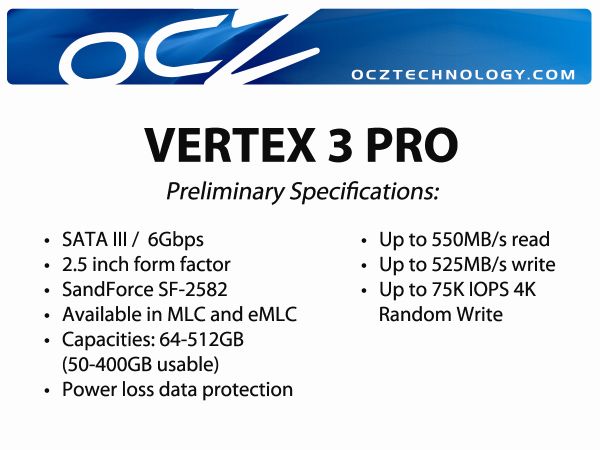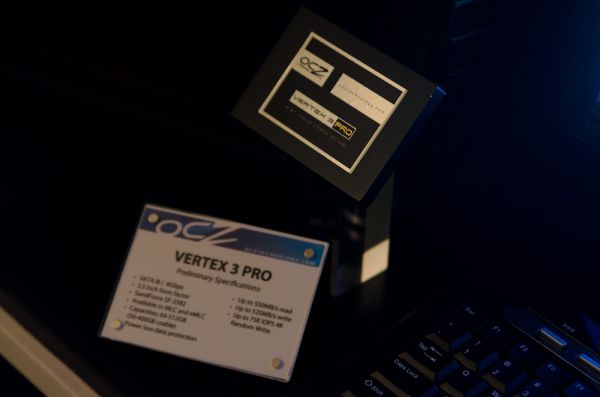OCZ'z Vertex 3 Pro Demo: World's First SandForce SF-2000
by Anand Lal Shimpi on January 5, 2011 9:37 PM ESTA few months ago SandForce announced its second generation SSD controller: the SF-2000 series. The specs SandForce released at the time were almost too good to be true. As a refresher here’s what we saw back in October of last year:

SandForce is promising a single enterprise level drive that can deliver 500MB/s sequential reads and writes (for highly compressible data), and up to 60K IOPS for 4KB random reads and writes. That’s not an evolutionary improvement, that’s more than a doubling of what most of the competition can do today. Even compared to existing SandForce drives it’s a huge increase in performance. But as I’ve heard many times before, anyone can put out a promising PDF.
Today at CES, OCZ previewed its first SF-2000 based drives: the Vertex 3 Pro and Vertex 3 EX. Both are based on SandForce’s SF-2582 controller, the highest end offering in the SF-2000 family. The drives won’t see the light of day for months (sometime in Q2) and what OCZ is showing today is very, *very* early silicon and hardware. The drives are using 32nm Toshiba toggle-mode NAND (effectively DDR NAND), however OCZ will go to market with 25nm Intel NAND when the drive is ready.
First let’s look at the specs OCZ is promising for these drives:
OCZ’s specs are even higher than SandForce’s. This is getting ridiculous. Thankfully, OCZ let me run some of my own Iometer tests on the drives to verify the claims. Surprisingly enough, the Vertex 3 Pro looks like it’s really as fast as OCZ and SandForce are claiming. When running highly compressible data (pseudo random in Iometer) at low queue depths, I get 518MB/s sequential write speed and nearly 500MB/s for sequential read speed. Remember this is the very first version of the drive and there’s months of tweaking ahead to get it ready for production. Performance may even increase by the time OCZ actually ships the drive. Furthermore, this is the performance of a single drive with a single controller - there’s no funny on-board RAID going on, we’re just talking about the performance of a single drive.
| OCZ Vertex 3 Pro Preliminary Test Data | ||||
| Iometer 2010 Test | Incompressible Data | Compressible Data | ||
| 128KB Sequential Write (QD=3) | 262.MB/s | 518.2MB/s | ||
| 128KB Sequential Read (QD=3) | 493.4MB/s | 492.3MB/s | ||
| 4KB Random Read (QD=3) | 186.5MB/s | N/A | ||
| 4KB Random Write (QD=3) | 162.7MB/s | 227.0MB/s | ||
Even if we look at incompressible data (fully random), the performance is unbelievable. You get better minimum performance on the SF-2582 than peak performance on the SF-1200/SF-1500. Note that we couldn't run all of our tests given the very early nature of the hardware sample. The fact that we could get these numbers at all on the first beta of the drive was beyond impressive.
Obviously to hit these speeds you need a 6Gbps controller. Thankfully there are at least a few ways to get those ports.
It’s looking like SandForce will be last to bring out their next-generation drive in the first half of the year with both Micron and Intel beating it to the punch, but if we can get this sort of performance, and have it be reliable, it may be worth the wait.


















62 Comments
View All Comments
B3an - Thursday, January 6, 2011 - link
Can anyone tell me how i could RAID these drives with 6Gb/s on a motherboard with no SATA 6Gb/s?Are there any PCI-E RAID controllers for this that dont cost a ton?
tipoo - Thursday, January 6, 2011 - link
When a startup can compete with a giant. Right now it looks as if Sandforce, with limited funds and only a relative handful of employees, is the only company that can put up a fight against the mighty Intel controller.bobbozzo - Thursday, January 6, 2011 - link
Please explain the compression comments and tables... is the drive compressing all data?Thanks,
Bob
dertechie - Thursday, January 6, 2011 - link
That's part of the Sandforce secret sauce. The control ASIC has some amount of (probably fixed function) compression/decompression hardware. This is what gets them their low write amplification and their fast speeds. As you can see, the controller is still fast if it can't compress the data, but not as fast as it is when you feed it something highly compressible.janon123 - Thursday, January 6, 2011 - link
What is the total 4KB random writes that can be done to each drive type in its lifespan?Intel X25-E (G3) 25nm eMLC 100GB is rated at 900TB-1PB total 4KB random writes.
janon123 - Thursday, January 6, 2011 - link
and are any of these Vertex 3 drives capacitor-backed?DarkRogue - Thursday, January 6, 2011 - link
I would assume the slide that reads "Power loss data protection" would mean it includes a cap to flush data to NAND in the event of a power loss.AbRASiON - Friday, January 7, 2011 - link
Over 180mb/s 4k READS is what I've been waiting for.This SSD, coupled with an absoloute meaty CPU and lots of ram will be awesome.
Forget sequential read and writes, they are mostly meaningless rubbish once they get over 200mb/s - this baby is going to load games and applications exceedingly quick. Damn glad I skipped the C300.
I am eager I tell you.
qax - Saturday, January 8, 2011 - link
I would like to see 2 of these controllers on af PCI-E PCB.amjustice - Friday, January 14, 2011 - link
I was holding off on getting a new SSD to put in my Macbook Pro until this next gen of drives comes out. Since I do not have the proper controller on my MBP to do 6GBPS is it worth it to wait still? Will I be able to see some of the benefits of speed in these drives?